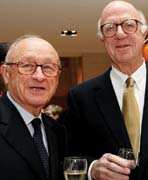
I had the honor of attending The Gap's "Project Red" Party at Yerbe Buena Gardens in San Francisco on Tuesday of last week (from the date of this post). It was a star-studded affair with people like former SF 49ers Quarterback Steve Bono, Mayor Gavin Newsom, and so many people of note that I needed a score-card to keep up with who was whom.
One of those people was Gap Founder Donald Fisher. Fisher (pictured with Budd Cheit at a Haas Business School gathering at Cal) -- natily dressed in a cashmere blazer, slacks, and his trademark coke-bottle glasses -- was just standing and talking to a gentleman who represented the country of Ridwanda, when me and my friend -- who were standing close to them because it was crowded -- turned and the four of us started a basic conversation of greeting. But after the formal intros were done, I asked Don about his son Jon's team, the Oakland A's.
He shared with me how his son was following the team and how proud they both were. I then offered the observation that I understood that they planned to move to Fremont, but the city couldn't afford them. I questioned the logic of the move -- in a friendly way. Our conversation wasn't negative by any stretch.

"Oh. They've got a good way to pay for it," Fisher offered. While hesitant to explain what the method was at first, he did after some playful and mischievious proding by me. Fisher said that the land they were buying would be obtained at a far lower than market value price, and they would just resell the land at a higher price. The difference between the first price -- which I'm guessing would be close to zero -- and their resale price is (they claim) enough to pay for a new stadium or at least a good portion of the cost of it.
I said it was a good idea.
What I now understand is why the A's need over 140 acres of land; to make this financing system work. What do I mean? Well, the more land they have to sell, the more residual money is left over to build a stadium.
What's the downside?
The market value of the land parcels in question after development is the biggest one. If the A's developers have not correctly calculated the size and number of parcels needed to generate the $500 million required, and they've not drawn a large enough "cushion" of land parcels to give them money over and above what's needed, they could wind up short.
But that written, it's a good idea that in theory should leave them without the $20 million annual stadium debt the San Francisco Giants are paying on AT&T Park.
Where's Oakland in all this? Not even the City of Oakland seems to know.






0 comments:
Post a Comment